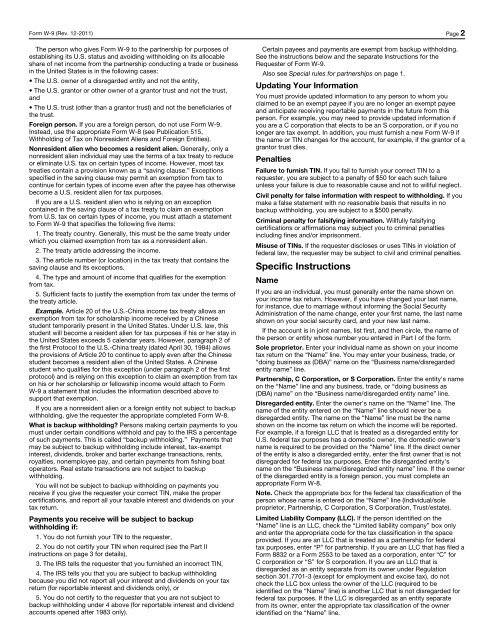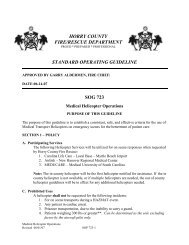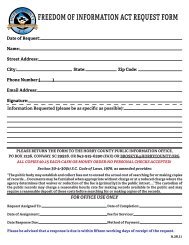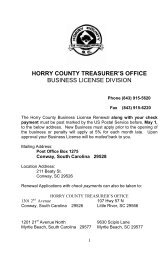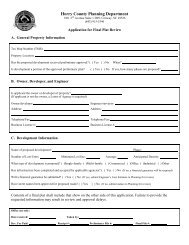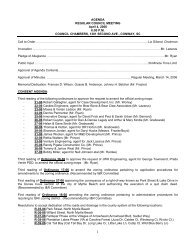PDF Bidder Application - Horry County Government
PDF Bidder Application - Horry County Government
PDF Bidder Application - Horry County Government
Create successful ePaper yourself
Turn your PDF publications into a flip-book with our unique Google optimized e-Paper software.
Form W-9 (Rev. 12-2011) Page 2The person who gives Form W-9 to the partnership for purposes ofestablishing its U.S. status and avoiding withholding on its allocableshare of net income from the partnership conducting a trade or businessin the United States is in the following cases:• The U.S. owner of a disregarded entity and not the entity,• The U.S. grantor or other owner of a grantor trust and not the trust,and• The U.S. trust (other than a grantor trust) and not the beneficiaries ofthe trust.Foreign person. If you are a foreign person, do not use Form W-9.Instead, use the appropriate Form W-8 (see Publication 515,Withholding of Tax on Nonresident Aliens and Foreign Entities).Nonresident alien who becomes a resident alien. Generally, only anonresident alien individual may use the terms of a tax treaty to reduceor eliminate U.S. tax on certain types of income. However, most taxtreaties contain a provision known as a “saving clause.” Exceptionsspecified in the saving clause may permit an exemption from tax tocontinue for certain types of income even after the payee has otherwisebecome a U.S. resident alien for tax purposes.If you are a U.S. resident alien who is relying on an exceptioncontained in the saving clause of a tax treaty to claim an exemptionfrom U.S. tax on certain types of income, you must attach a statementto Form W-9 that specifies the following five items:1. The treaty country. Generally, this must be the same treaty underwhich you claimed exemption from tax as a nonresident alien.2. The treaty article addressing the income.3. The article number (or location) in the tax treaty that contains thesaving clause and its exceptions.4. The type and amount of income that qualifies for the exemptionfrom tax.5. Sufficient facts to justify the exemption from tax under the terms ofthe treaty article.Example. Article 20 of the U.S.-China income tax treaty allows anexemption from tax for scholarship income received by a Chinesestudent temporarily present in the United States. Under U.S. law, thisstudent will become a resident alien for tax purposes if his or her stay inthe United States exceeds 5 calendar years. However, paragraph 2 ofthe first Protocol to the U.S.-China treaty (dated April 30, 1984) allowsthe provisions of Article 20 to continue to apply even after the Chinesestudent becomes a resident alien of the United States. A Chinesestudent who qualifies for this exception (under paragraph 2 of the firstprotocol) and is relying on this exception to claim an exemption from taxon his or her scholarship or fellowship income would attach to FormW-9 a statement that includes the information described above tosupport that exemption.If you are a nonresident alien or a foreign entity not subject to backupwithholding, give the requester the appropriate completed Form W-8.What is backup withholding? Persons making certain payments to youmust under certain conditions withhold and pay to the IRS a percentageof such payments. This is called “backup withholding.” Payments thatmay be subject to backup withholding include interest, tax-exemptinterest, dividends, broker and barter exchange transactions, rents,royalties, nonemployee pay, and certain payments from fishing boatoperators. Real estate transactions are not subject to backupwithholding.You will not be subject to backup withholding on payments youreceive if you give the requester your correct TIN, make the propercertifications, and report all your taxable interest and dividends on yourtax return.Payments you receive will be subject to backupwithholding if:1. You do not furnish your TIN to the requester,2. You do not certify your TIN when required (see the Part IIinstructions on page 3 for details),3. The IRS tells the requester that you furnished an incorrect TIN,4. The IRS tells you that you are subject to backup withholdingbecause you did not report all your interest and dividends on your taxreturn (for reportable interest and dividends only), or5. You do not certify to the requester that you are not subject tobackup withholding under 4 above (for reportable interest and dividendaccounts opened after 1983 only).Certain payees and payments are exempt from backup withholding.See the instructions below and the separate Instructions for theRequester of Form W-9.Also see Special rules for partnerships on page 1.Updating Your InformationYou must provide updated information to any person to whom youclaimed to be an exempt payee if you are no longer an exempt payeeand anticipate receiving reportable payments in the future from thisperson. For example, you may need to provide updated information ifyou are a C corporation that elects to be an S corporation, or if you nolonger are tax exempt. In addition, you must furnish a new Form W-9 ifthe name or TIN changes for the account, for example, if the grantor of agrantor trust dies.PenaltiesFailure to furnish TIN. If you fail to furnish your correct TIN to arequester, you are subject to a penalty of $50 for each such failureunless your failure is due to reasonable cause and not to willful neglect.Civil penalty for false information with respect to withholding. If youmake a false statement with no reasonable basis that results in nobackup withholding, you are subject to a $500 penalty.Criminal penalty for falsifying information. Willfully falsifyingcertifications or affirmations may subject you to criminal penaltiesincluding fines and/or imprisonment.Misuse of TINs. If the requester discloses or uses TINs in violation offederal law, the requester may be subject to civil and criminal penalties.Specific InstructionsNameIf you are an individual, you must generally enter the name shown onyour income tax return. However, if you have changed your last name,for instance, due to marriage without informing the Social SecurityAdministration of the name change, enter your first name, the last nameshown on your social security card, and your new last name.If the account is in joint names, list first, and then circle, the name ofthe person or entity whose number you entered in Part I of the form.Sole proprietor. Enter your individual name as shown on your incometax return on the “Name” line. You may enter your business, trade, or“doing business as (DBA)” name on the “Business name/disregardedentity name” line.Partnership, C Corporation, or S Corporation. Enter the entity's nameon the “Name” line and any business, trade, or “doing business as(DBA) name” on the “Business name/disregarded entity name” line.Disregarded entity. Enter the owner's name on the “Name” line. Thename of the entity entered on the “Name” line should never be adisregarded entity. The name on the “Name” line must be the nameshown on the income tax return on which the income will be reported.For example, if a foreign LLC that is treated as a disregarded entity forU.S. federal tax purposes has a domestic owner, the domestic owner'sname is required to be provided on the “Name” line. If the direct ownerof the entity is also a disregarded entity, enter the first owner that is notdisregarded for federal tax purposes. Enter the disregarded entity'sname on the “Business name/disregarded entity name” line. If the ownerof the disregarded entity is a foreign person, you must complete anappropriate Form W-8.Note. Check the appropriate box for the federal tax classification of theperson whose name is entered on the “Name” line (Individual/soleproprietor, Partnership, C Corporation, S Corporation, Trust/estate).Limited Liability Company (LLC). If the person identified on the“Name” line is an LLC, check the “Limited liability company” box onlyand enter the appropriate code for the tax classification in the spaceprovided. If you are an LLC that is treated as a partnership for federaltax purposes, enter “P” for partnership. If you are an LLC that has filed aForm 8832 or a Form 2553 to be taxed as a corporation, enter “C” forC corporation or “S” for S corporation. If you are an LLC that isdisregarded as an entity separate from its owner under Regulationsection 301.7701-3 (except for employment and excise tax), do notcheck the LLC box unless the owner of the LLC (required to beidentified on the “Name” line) is another LLC that is not disregarded forfederal tax purposes. If the LLC is disregarded as an entity separatefrom its owner, enter the appropriate tax classification of the owneridentified on the “Name” line.


